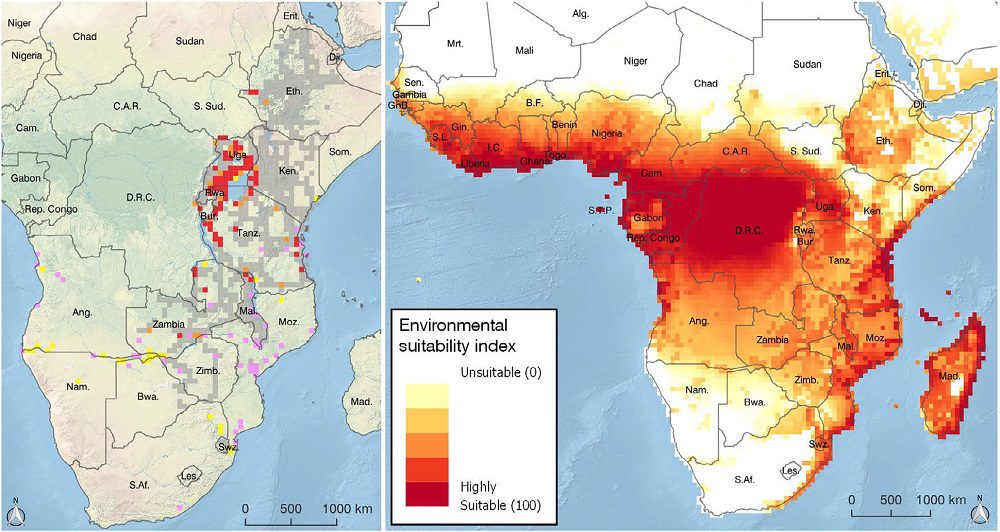Farmers and fishers believe livelihoods would be enhanced by removal of semiaquatic weed in Zambia
Survey with farmers and fishers along the Kafue River floodplains indicates that an invasive semiaquatic weed reduces yields, fish catches and bird diversity. In their view, removing this weed would hence benefit local livelihoods and biodiversity.
Farmers and fishers living along the Kafue River floodplains in Zambia believe that removal of the invasive semiaquatic weed Mimosa pigra would ‘considerably enhance’ their livelihoods, according to new research undertaken by CABI scientists and published in Austral Ecology.
Dr Arne Witt, based at CABI’s centre in Nairobi, Kenya, led a team of researchers who mapped the distribution of M. pigra in eastern and southern Africa before comparing that with the potential spread of the weed based upon an ecoclimatic niche CLIMEX model described by Walden et al (2004).
The scientists then surveyed 164 households – the majority of which were farmers and fishers – who agreed that M. pigra has negative impacts on biodiversity, fishing, crop and livestock production and tourism in most places where it has been introduced, established and proliferated.
Mimosa has been present in Africa for almost 200 years though it was only reported on the Kafue River floodplains a relatively short time ago in the late 1970s. In 1986 it occupied about 100 hectares but quickly increased its spread to more than 2,500 hectares by 2003.
The researchers also found it be invasive in western Ethiopia, around the shores of Lake Victoria and Lake Tanganyika, and along the Tanzanian coastline, northern Malawi, parts of Mozambique and in the Barotse floodplain on the Zambezi River in Zambia.
It is feared that the presence of upstream impoundments on the Zambezi River has already reduced the high peak average monthly flows by 17 per cent and increased the average monthly low flows by 5 per cent, putting the floodplains in the Mana Pools National Park, Zimbabwe, also at risk of invasions.

Map (left) shows current known distribution of Mimosa pigra in eastern and southern Africa using data collected in Dr Witt’s study and other sources of information. Map (right) shows areas that are ecoclimatically suitable for the establishment of Mimosa pigra based on a CLIMEX model described by Walden et al (2004).
Of the households surveyed, 97 per cent said mimosa invasions reduced yields, with maize being worst affected. About 68 per cent of respondents said that maize yields would be reduced by more than 75 per cent if mimosa was not controlled.
Most (97 per cent) respondents said that mimosa invasions also reduced fish catches with 72 per cent saying that catches were reduced by 51–75 per cent. According to 42 per cent of respondents, reduced fish sales resulted in financial losses of US$169–422, with 3 per cent of fishers reporting losses of US$845–4233 per annum.
Dr Witt said, “Many of the ecological impacts are well known, but mimosa’s impacts on rural livelihoods are less well documented, especially in Africa. While it may have some potential benefits, its propensity to establish dense monospecific stands means that it impacts negatively on biodiversity, crop and livestock production,
and fisheries.
“Active and focussed management of mimosa will be required if the impacts associated with invasions are to be mitigated as part of a two-part action plan. Farmers wish to clear mimosa from land intended for crop production and a coordinated effort between multiple stakeholders would be required to manage landscape-scale invasions where the goal is to contain and, ultimately, eliminate the spread.”
Dr Witt adds that ‘given the considerable costs associated with manual and chemical control, and the rapidly increasing extent of invasions,’ it would be prudent to make use of sustainable biological controls wherever possible in combination with the aforementioned methods. To that end CABI recently introduced the host specific and damaging biological control agent Carmenta mimosa to Zambia.
The scientists concluded by highlighting a study by co-author Griffin Shanungu (2009) who recorded a 50 per cent reduction in bird diversity as a result of the mimosa invasion on the Kafue floodplains.
Full paper reference:
Arne B.R. Witt, Kelvin S. Floyd, Winnie Nunda, Tim Beale, Griffin Shanungu and Darren J. Kriticos, ‘Mimosa pigra in eastern and southern Africa: Distribution and socio-ecological impacts,’ May 2020, Austral Ecology, DOI: 10.111/aec.1285
The paper can be viewed here.